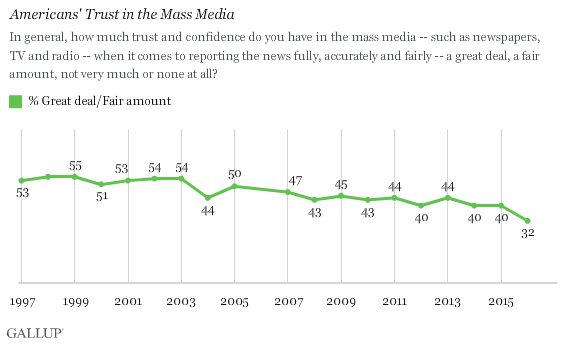BY DAVID SNYDER–Journalism in the age of Trump, as told through some key numbers and a familiar Dickensian device:
Story #1 (the best of times)
- In the last quarter of 2016, the New York Times had 276,000 new digital subscriptions, the largest three-month jump in six years, and in February the Times exceeded three million paid print and digital subscriptions.
- Large newspapers and magazines are reporting similar surges across the board.
- Contributions to nonprofit journalism outlets have soared, and show no sign of coming down.
Story #2 (the worst of times)
- Americans’ trust and confidence in the mass media “to report the news fully, accurately and fairly” recently dropped to its lowest level in Gallup polling history, with just 32% saying they have a great deal or fair amount of trust in the media.
- Six percent of people say they have a great deal of confidence in the press, about the same level as Congress.
- –Just twenty-three percent of American adults agree with the statement that “overall, the news media tries to report the news without bias,” while 74 percent disagree.
Can these two tales be reconciled? It seems inconsistent, at least, that Americans simultaneously think the media is only slightly more trustworthy than Congress, that they feel that way more so than at any time in decades, and yet are also consuming (and paying for) news at a rate unseen in many years.
A third set of numbers offers one way to understand both stories: Preliminary polling suggests that, as much as the American public distrusts the media, they distrust the current occupant of the White House even more — a remarkable development, given that the President typically commands approval ratings far greater than the press, which usually in the basement with Congress and lawyers.
In February, the Quinnipiac poll found that 52 percent of Americans say they trust the media more than Trump to tell the truth about important issues, while only 37 percent trust Trump more. Several weeks later, the number was essentially the same–53 percent to 37 percent.
Now, there is at least one poll suggesting the gap is not so wide. But entertain the notion that the recent boom in reader interest reflects a deeper, and potentially longer-lasting phenomenon: a desire for a corrective to the fact-free bluster emanating from the White House, which mirrors and amplifies the bluster and falsehoods found so often on social media platforms, talk radio and the like.
It’s possible — just possible — that the American public is waking back up to the critical role the “mainstream media” plays in our Democracy, and that by simply doing their jobs journalists are providing an increasingly valuable commodity in a world of “alternative facts:” the pursuit, flawed though it may be, of objective truth.
It’s folly to draw too draw sweeping conclusions from a smattering of polls, of course, and the “real” story won’t be clear for quite some time. But if this story is right and if Trump’s credibility continues to fall, it could be that Donald Trump becomes the best thing to happen to journalism in years–a startling possibility, given the President’s vigorous and unprecedented self-declared “war” on the press.
Another possibility: the current surge in monetized interest in the press is nothing more than a temporary “Trump bump” — that Trump’s sui generis presidency, with all of its self-created chaos and acrimony, is like the proverbial train wreck: People can’t take their eyes off it, though they may not believe what they see. They will adjust, and so will the numbers.
This appears to be the conventional wisdom, and it may be correct. But the public’s clearly heightened interest in reading the news — now sustained for more than three months — suggests that people have not yet given up on the media, or on the idea that there is such a thing as objective fact.
Let’s not get ahead of ourselves, though. Because these numbers tell us that the press has a long, long way to go:

